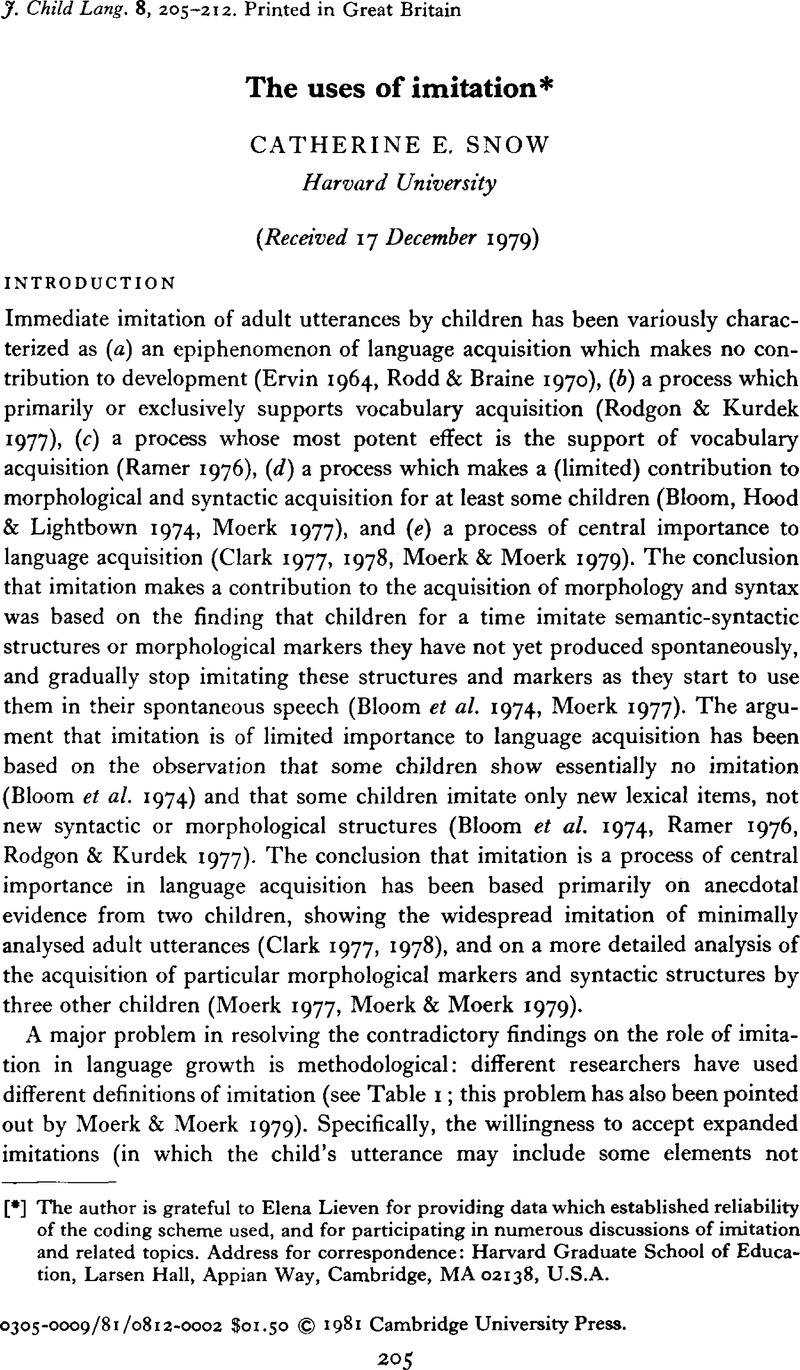Crossref Citations
This article has been cited by the following publications. This list is generated based on data provided by
Crossref.
Kuczaj, Stan A.
1982.
Advances in Child Development and Behavior Volume 17.
Vol. 17,
Issue. ,
p.
197.
Bell, Ian
1985.
Communication and language in mental handicap.
Journal of the British Institute of Mental Handicap (APEX),
Vol. 13,
Issue. 2,
p.
65.
Réger, Zita
1986.
The functions of imitation in child language.
Applied Psycholinguistics,
Vol. 7,
Issue. 4,
p.
323.
Kirchner, Diane M.
and
Prutting, Carol A.
1987.
Spontaneous verbal repetition: A performance-based strategy for language acquisition.
Clinical Linguistics & Phonetics,
Vol. 1,
Issue. 2,
p.
147.
Gaines, Rosslyn
Leaper, Campbell
Monahan, Caroline
and
Weickgenant, Anne
1988.
Language learning and retention in young language-disordered children.
Journal of Autism and Developmental Disorders,
Vol. 18,
Issue. 2,
p.
281.
Kirchner, Diane M.
1988.
Using Verbal Scaffolding To Facilitate Conversational Participation and Language Acquisition in Children With Pervasive Developmental Disorders.
Journal of Childhool Communication Disorders,
Vol. 14,
Issue. 1,
p.
81.
Vincent, Nigel
1989.
Observing obsolescence.
Behavioral and Brain Sciences,
Vol. 12,
Issue. 2,
p.
360.
Rizzi, Luigi
1989.
On the format for parameters.
Behavioral and Brain Sciences,
Vol. 12,
Issue. 2,
p.
355.
Snow, Catherine E.
and
Tomasello, Michael
1989.
Data on language input: Incomprehensible omission indeed!.
Behavioral and Brain Sciences,
Vol. 12,
Issue. 2,
p.
357.
Speidel, Gisela E.
and
Nelson, Keith E.
1989.
The Many Faces of Imitation in Language Learning.
Vol. 24,
Issue. ,
p.
1.
Buckingham, Hugh W.
1989.
On triggers.
Behavioral and Brain Sciences,
Vol. 12,
Issue. 2,
p.
335.
Bohannon, John Neil
and
Stanowicz, Laura
1989.
The Many Faces of Imitation in Language Learning.
Vol. 24,
Issue. ,
p.
121.
Schlesinger, I. M.
1989.
Language acquisition: Dubious assumptions and a specious explanatory principle.
Behavioral and Brain Sciences,
Vol. 12,
Issue. 2,
p.
355.
Snow, Catherine E.
1989.
The Many Faces of Imitation in Language Learning.
Vol. 24,
Issue. ,
p.
73.
Morgan, James L.
1989.
Learnability considerations and the nature of trigger experiences in language acquisition.
Behavioral and Brain Sciences,
Vol. 12,
Issue. 2,
p.
352.
Meltzoff, Andrew N.
and
Gopnik, Alison
1989.
The Many Faces of Imitation in Language Learning.
Vol. 24,
Issue. ,
p.
23.
Koster, Jan
1989.
Does Universal Grammar exist?.
Behavioral and Brain Sciences,
Vol. 12,
Issue. 2,
p.
347.
Lightfoot, David
1989.
Matching parameters to simple triggers.
Behavioral and Brain Sciences,
Vol. 12,
Issue. 2,
p.
364.
Lorch, Marjorie Perlman
1989.
The true nature of the linguistic trigger.
Behavioral and Brain Sciences,
Vol. 12,
Issue. 2,
p.
350.
Tomasello, Michael
Gust, Deborah
and
Frost, G. Thomas
1989.
A longitudinal investigation of gestural communication in young chimpanzees.
Primates,
Vol. 30,
Issue. 1,
p.
35.



